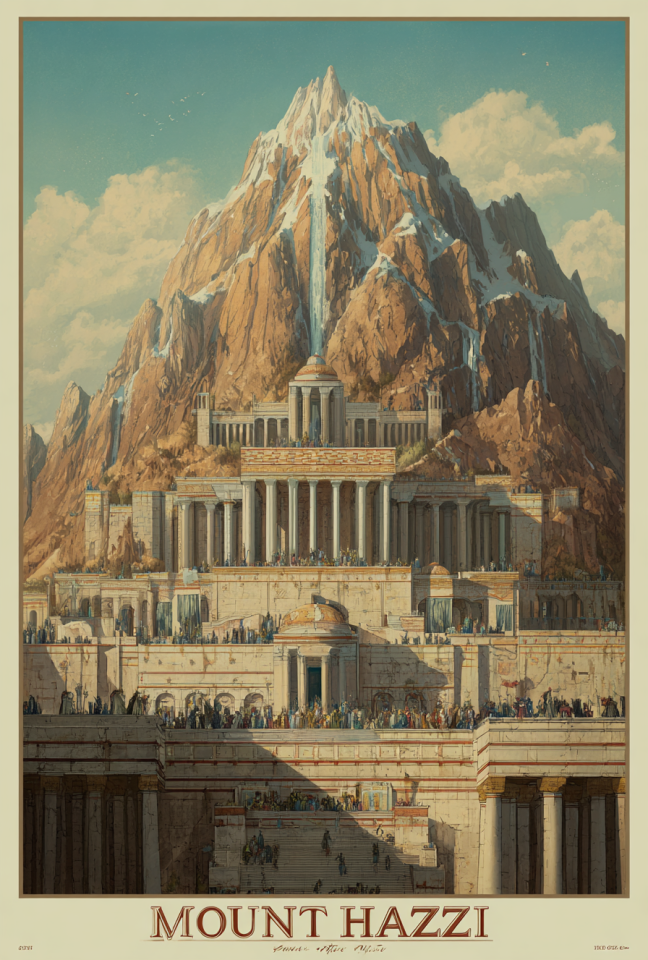Mount Hazzi is the storm-forged bastion of elemental order — a Divine Realm where thunder is law, lightning is language, and divine treaties are etched into the sky itself. Anchored in the sacred geography of the Hittite and Hurrian cosmos, Hazzi was not a mythic peak but a real metaphysical summit where gods met in combat and covenant. It is the fortress of the storm god Teshub, carved not from stone, but from the collision of wind and will. Here, law is not spoken but declared, and peace is a contract hammered by force. The mountain was once glimpsed in storms and high citadels, but with the silence of temples and the rise of foreign names, Hazzi vanished behind the Veil — sealed in crackling air.
Landscape and Essence
Mount Hazzi towers as a jagged spiral above a sea of swirling stormclouds. Its slopes are iron-dark and veined with flickering energy — a mountain that quakes not in fear, but in vigilance. Gales roar continuously across its ridges, but within its halls, silence reigns. At its peak stands the **Hall of Accord**, a vast chamber of black basalt and skyglass where lightning writes itself across vaulted ceilings. Thunder here is sentient; each rumble carries the weight of former oaths. Lightning does not strike Hazzi — it bows to it. Time is not measured by seasons but by intervals of judgment and revelation, each marked by a moment of stillness before the next tempest.
Inhabitants
At Hazzi’s summit resides **Teshub**, storm lord and divine enforcer, crowned not with jewels but with the echo of thunderclaps. He is not alone — the realm is watched by **Hepat**, his consort, whose calm hand tempers his storm, and their divine court of elemental beings: wind-lions, sky-bulls, and storm-scribes carved from cloud and command. The *weather gods*, the *sacred bulls* (Seris and Hurri), and deified ancestors of the Hittite royal line dwell here in roles of counsel or eternal stewardship. No mortal soul is permitted residence, though some kings were granted brief audience in trance or death, bearing offerings of law and lineage.
Cultural Significance
To the Hittites, Mount Hazzi was not distant — it was near, ever-rumbling, ever-watching. The divine battles between Teshub and Kumārbi, or the monstrous Ullikummi, were not stories, but sacred precedents — echoes of cosmic struggle maintained at Hazzi’s height. Royal oaths were believed to be witnessed from this realm, and treaties were sealed under its imagined shadow. Temples to the Storm God across Hattusa, Aleppo, and Ugarit all gestured toward Hazzi, their altars oriented like watchtowers. Even after the fall of the empire, Hazzi’s name lingered in storms, in ritual curses, and in mountaintop shrines that refused to erode.
Role in the Divine Realm
Mount Hazzi serves as the fulcrum of **divine contract** — a realm where order is enforced through mutual reckoning, not passive harmony. It is the courtroom of storms, where deities declare, challenge, and reaffirm their roles in the great cycle. Hazzi does not govern fertility, rebirth, or reward — it governs **responsibility**. It is the realm where gods who make vows must return to justify them, and where storms themselves are braided into the fabric of justice. Its very existence anchors the metaphysical laws that prevent divine collapse.
Interactions with Other Realms
Once, Mount Hazzi could be reached through mountain sanctuaries, storm-wracked heights, and sacred caves where lightning struck in ritual pattern. Some priests, known as storm-interpreters, could channel visions from the Hall of Accord and speak decrees with unusual force. But as the great cities of Anatolia fell and the rites were forgotten, the paths to Hazzi fell dormant. The Veil did not close quietly — it did so with thunder, sealing the realm with a final storm that was never fully remembered. Now, only Teshub and his chosen kin may cross freely, and only during acts of immense divine arbitration are others permitted to enter.
















